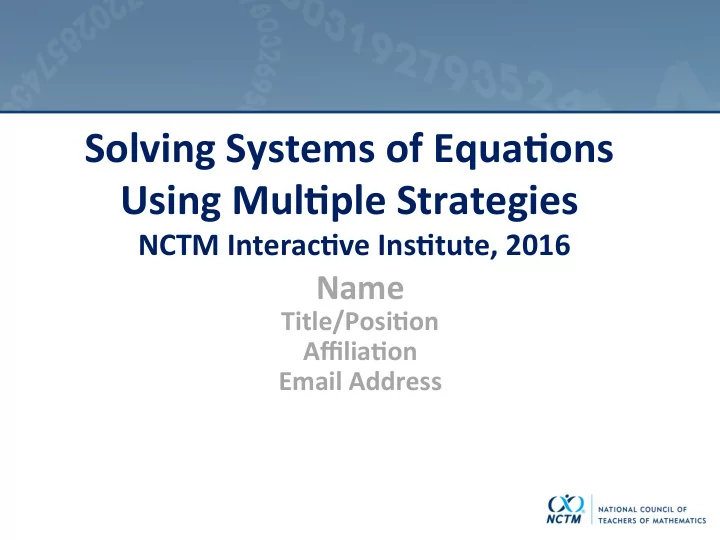

Solving Systems of Equa3ons Using Mul3ple Strategies NCTM Interac3ve Ins3tute, 2016 Name Title/Posi3on Affilia3on Email Address
Common Core Standards This session will address the following: 8.EE.8a Understand that solu8ons to a system of two linear equa8ons in two variables correspond to points of intersec8on of their graphs, because points of intersec8on sa8sfy both equa8ons simultaneously. 8.EE.8b Solve systems of two linear equa8ons in two variables algebraically, and es8mate solu8ons by graphing the equa8ons. Solve simple cases by inspec8on. Solve real-world and mathema8cal problems leading to two linear 8.EE.8c equa8ons in two variables. 2
Warm Up Find two different equa8ons that are sa8sfied by the point (5, -2). Describe the rela8onship of the graphs of your equa8ons. 3
Warm Up Discussion • What strategies did you use to find two equa8ons that sa8sfy the point (5, -2)? • What are some other strategies we could have used? 4
Going Bananas! Consider. . . A banana peel weighs one-eighth the total weight of a banana. If an unpeeled banana balances a peeled banana of the same weight plus seven-eighths of an ounce, how much does a banana weigh with peel? 5
Going Bananas What did you have to understand in order to solve this problem? 6
Consider this student diagram. . . Maida, P. (2004). Using algebra without realizing it. 7 Mathematics Teaching in the Middle School . 9(9).
Chicken Problem 8
Chicken Problem Solu3ons What did you no8ce about students’ solu8ons? 9
Solving Systems of Equa3on What strategies can be used to solve systems of equa8ons? 10
Strategies • Elimina8on • Subs8tu8on • Graphing • Calculator • Manipula8ves 11
Consider When is one strategy “beZer” than another? 12
Sequencing Instruc3on Think about the instruc8onal sequence you use in teaching how to solve systems of equa8ons. What do students do first in the lessons? How do the lessons change over 8me? 13
KnoQy Problem In groups, you will use the meter s8ck and rope to complete the KnoZy Problem. 14
KnoQy Problem • What observa8ons and paZerns have you no8ced? • What does the y -intercept represent? • What does the slope represent? 15
KnoQy Problem - extension • Pair up with another group, and exchange “rules”. • Make a predic8on: Assuming each group started with equal lengths of rope, how many knots could you make in your rope so that it’s as close as possible to the same length as the rope from your partnering group with three knots? Use, pictures, words, and symbols to describe your solu=on. 16
Fish Problem How much does a fish weigh if its tail weights 4 kilograms, its head weighs as much as its tail and half its body, and its body weighs as much as its head and tail together? 17
Fish Problem • What were your ini8al thoughts about a strategy to solve the Fish Problem? • Was this strategy useful? • What other strategies could you have used? 18
Reflec3on ( Principles to Actions: Ensuring Mathematical Success for All [NCTM 2014], p. 47)
Reflec3on ( Principles to Actions: Ensuring Mathematical Success for All [NCTM 2014], p. 48)
How were you engaged in the Mathema3cal Prac3ces? 1. Make sense of problems and persevere in solving them. 2. Reason abstractly and quan8ta8vely. 3. Construct viable arguments • Banana Problem and cri8que the reasoning of others. • Chicken Problem 4. Model with mathema8cs. 5. Use appropriate tools • KnoZy Problem strategically. 6. AZend to precision. • Fish Problem 7. Look for and make use of structure. 8. Look for and express regularity in repeated reasoning. 21
Exit Ticket: Reflec3on • What new idea(s) do you want to implement into your classroom? • What challenges did you encounter during this session? 22
Disclaimer The National Council of Teachers of Mathematics is a public voice of mathematics education, providing vision, leadership, and professional development to support teachers in ensuring equitable mathematics learning of the highest quality for all students. NCTM ’ s Institutes, an official professional development offering of the National Council of Teachers of Mathematics, supports the improvement of pre-K-6 mathematics education by serving as a resource for teachers so as to provide more and better mathematics for all students. It is a forum for the exchange of mathematics ideas, activities, and pedagogical strategies, and for sharing and interpreting research. The Institutes presented by the Council present a variety of viewpoints. The views expressed or implied in the Institutes, unless otherwise noted, should not be interpreted as official positions of the Council. 23
24
Recommend
More recommend